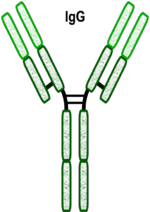Immunoglobulin G
Revision as of 16:25, 12 June 2010 by A.allison (talk | contribs) (Created page with '{{review}} <p>''Shortened to IgG''</p> thumb|150px|right|'''IgG''' thumb|right|150px|IgG - B. Catchpole, RVC 2008 <p>IgG is the major antib…')
| This article has been peer reviewed but is awaiting expert review. If you would like to help with this, please see more information about expert reviewing. |
Shortened to IgG
IgG is the major antibody in blood plasma and constitutes at least 80% of all antibody in the body. It is the smallest immunoglobulin so it can readily leave the blood plasma and enter tissues.
Structure
IgG is Y-shaped with three constant regions and a heavy chain subunit type γ. There are several different IgG subclasses depending on the species coded for by the IGHG gene.
- Ruminants have three subclasses
- G1-G3
- IgG1 is the major antibody in ruminant mucosal secretions and colostrum
- Dogs, rodents (and cats?) have four subclasses
- Dogs: G1-G4
- Rodents: G1-G3 (G2a, G2b)
- Pigs have five subclasses
- G1-G4 (G2a, G2b)
- Horses have six subclasses
- G1-G6
Production
IgG is produced by plasma cells in the spleen, bone marrow and lymph nodes.
Function
- Some IgG subclasses can activate complement via the classical pathway
- Some subclasses act as targets for macrophages, eosinophils and neutrophils
- It is therefore the major antibody in tissue fluids and lymph
- IgG specifically binds to antigens on bacteria
- Causing agglutination and opsonisation

